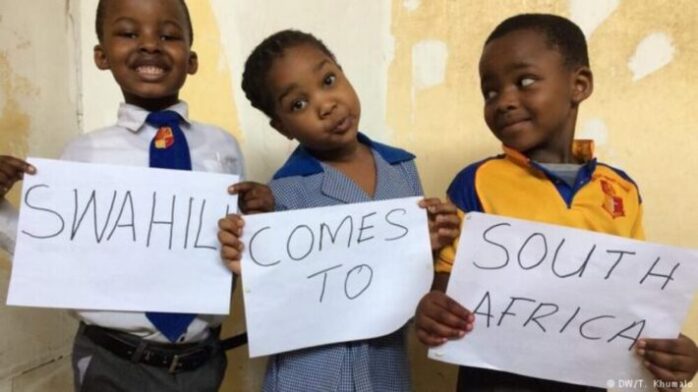
The African continent is known for the vivid tribes that have been inhabiting it since ancient times. Thanks to their diversity and peculiarity, numerous different languages have developed from their cultural nests – and today we can divide them into five large groups. These are the Afro-Asian language group (otherwise called Semitic-Hamitic), then the Nile-Saharan, Niger-Congolese, Kojsan, and finally the Malagasy languages.
And, regarding this… well, we believe you have had the opportunity to hear about Swahili. Or better said, it seems to be one of the languages that you knew it existed, but you didn’t have a chance to learn more about it from available sources. Maybe because it isn’t studied enough at the places where we live. Or you just didn’t get a chance to go on a trip to Africa and hear it live.
And that’s why we’re here – to help you start learning about this magical and special language, as we believe it deserves your attention.
Origin

To start with, this exotic language is considered to have originated from the time when trade was developing on the East African coast of the Indian Ocean. This period is associated with the first centuries of the new era when Arab traders from the Middle East slowly began to arrive, offer and sell their goods to the local African population.
At that time, it was known as a lingua franca and it was first used among the tribes that speak Bantu. It’s also recognized by its speakers as a Kiswahili – the word itself is of Arabic origin, meaning ‘’of the coast’’. However, all its speakers have their own variations of the language – they took over some Arab elements and that’s how today’s shape of it came into being.
History

As with the rest of African history, there’s little information about this between the period of development of trade with the Arabs and the colonial period. At the beginning of the 19th century, it first began to spread in the interior of the continent and kept growing in the direction of Uganda in the north and Congo in the west.
During the colonial period, German and British forces began to arrive: Europeans adopted various dialects specific for that area, especially the Germans, who used it for administrative work and communication in Tanganyika. In that way, they tried to implement it in Tanzania, as well.
The colonial powers planned on standardizing Swahili, especially the Zanzibar dialect, which they were quite fond of – and it finally happened in 1928. Thanks to this, after the end of this period, Tanzania and Kenya slowly began to introduce it in schools. And that’s how it began to grow.
Swahili was also widespread among missionaries. They used it as the main way of communication, transcribing it into Latin letters in order to make it accessible to the tribes in the interior of the eastern part. Therefore, we could say that it also appeared to be a solid educational asset.
The language also reached intermediary tribes who were buying goods on the coast and selling them to tribesmen in the interior – this kept spreading this written and spoken way of communication even more.
Where is it spoken?

A large number of people in the world speak this language – believe it or not. Some use it as their mother tongue, while some have chosen it as the second one. It’s estimated that the first group includes 16 million people, most of whom live in Tanzania, and the second group around 82 million. Not a tiny number, right?
The lingua franca was adopted as a general and universal means of communication. As you may have noticed, Tanzania makes up only a third of the total – the rest of the speakers are spread all over Uganda, the Democratic Republic of Congo and Kenya. But hey, that’s not all – this group also includes a smaller number of inhabitants from Somalia, Mozambique, Malawi, Rwanda, Burundi, and Northern Zambia.
Also, it’s used as an official form of communication in the East African Community, which includes Tanzania, Kenya, Uganda, Rwanda, Burundi, and South Sudan. In Tanzania, it’s still used in administrative work and is a compulsory subject in schools.
Several dialects stand out in particular, and three of them stand out from the others – Kiunguja, which is characteristic of Zanzibar, Kimvita in Mombasa, and Kiamu on the island of Lama.
Grammar

They say that, compared to other languages in Africa, Swahili is one of the easiest to learn. Can you believe that? Yes – it looks so hard to even read, and not to mention speaking and writing. Members of the English-speaking area and Arabs often say that it’s easiest for the inhabitants of those places where it’s used to learn English because of the similarity in the lexical tone.
The words are read as they’re written in most cases – no hard-to-learn diphthongs. On the other hand, as we have already mentioned, there are elements of Arabic in it, and that’s why Arabs mostly find it as easy as ABC.
Grammar doesn’t stand for something that’s immensely difficult and many root words can be associated with a Bantu group. Based on their singular or plural nouns, they’re divided into classes, and frequent prefixes that define verbs and possessive adjectives more closely are there, too. What is perceived as a difference in relation to English is the fact that particles are used at the beginning of words that determine time or person.
This also means that there’s a great demand for translators of this type. In addition to written translation, there are many other disciplines that involve working with this language and the checks to which texts must be exposed. For example interpreting, transcription, proofreading and many other activities, and it’s always possible to read more about on sites such as KL Translations as many agencies deal with it successfully. In this way, the awareness of the prevalence of Swahili, its applications and various other important things related to this topic is also spread.
Educational problem

The biggest problem? Swahili is still largely used as a means of communication in trade and among ethnic communities, but not everywhere it needs to be. The great need for educating children in schools is becoming increasingly necessary – in that way, it would find its own path to implementation in other places and ethnic communities.
On the other hand, it’s the subject of research at many universities in the United States and Europe, but also in South Africa. This fact speaks of its international significance, which makes everyone believe that its introduction into schools would have an excellent world significance for the continent.
The history of Swahili is long, but neither Africa nor the rest of the world is educated enough in this sense, which is why it isn’t so popular in our area. But still, we are sure you know at least something. If you don’t believe us, we’ll just remind you of ‘Hakuna Matata’ from the world-famous animated movie ‘The Lion King’. No worries, no trouble. Remember that? You see? That’s the way to go!











